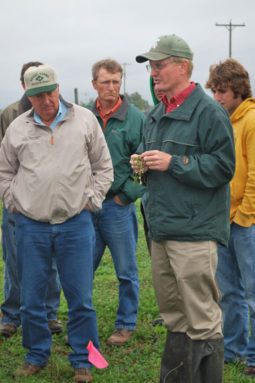Jason Rowntree, Michigan State University (MSU) animal scientist, sees this as not only a profitable way to use Michigan’s underutilized land, but as an ecologically sound one as well.
Rowntree and other MSU Extension specialists held a two-day grazing school for livestock and dairy producers at the Lake City Experiment Station on September 15 and 16, bringing in participants in conventional and organic cattle and dairy production, as well as those interested in simply learning more about grazing animals.
“There is so much available land in northern lower Michigan and its Upper Peninsula to be reclaimed for agricultural production,” Rowntree said.

“In the late 1970s, there were 200,000 head of ruminant animals being grazed in the state, now it’s down to around 80,000. I see no reason we couldn’t have tens of thousands of cattle, sheep and goats grazing on that land,” he noted.
“With the growing emphasis on more local food sources, this is one environmentally sound and sustainable way to keep a continuous food source.”
Participants soon realized that grazing not only involved being good animal producers but being good forage producers as well.
“The animals are the harvesters of the forage, so producers need to think ‘How best do I grow a quality crop and get it harvested by my animals at the peak of production?’ considering Michigan has too much of a winter season in contrast to its growing season,” said Kevin Gould, MSU Extension specialist.
On the first day of the school, participants learned that managed grazing takes into account plant growth, plant species selection for forage quality, soil fertility and management, how much animals graze in a given pasture area and the nutritional value the animals gain from the forages grazed.
As a “homework” project, participants split into groups and using the information gained, went into a pasture and marked off grazing areas for cattle in an effort to determine how much forage the cattle in the marked-off areas would graze by the next afternoon.
On the second day, participants learned more on the layout and design of grazing systems, and building and using fences. Gould explained how to manage water systems and water needs in rotational grazing areas.
Ben Bartlett, MSU Extension educator and grazing specialist from Michigan’s Upper Peninsula, emphasized that there are many ways to manage water, so producers don’t need to feel that water management is a roadblock to rotational grazing.
Other topics included being aware of animal health concerns, and establishing and improving pasture land.
During that afternoon, participants went back out into the field, where they had hands-on lessons in pasture plant species and the balance needed between grasses and legumes in pasture, led by Jerry Lindquist, MSU Extension educator.
They were also “graded” on their homework assignments and saw firsthand the different grazing techniques being tested at the Lake City Experiment Station. Allen Williams, of Tallgrass Beef in Sedan, Kan., led a discussion afterward on finishing cattle on grass.
Rowntree sees rotational grazing as being an economic plus and an efficient way to sequester carbon.
“With continuous grazing, only 10 percent to 20 percent of the pasture is utilized,” he said. “Using rotational grazing takes that to upwards of 40 percent to 50 percent. If you are more efficient in utilizing pasture, you are spending less time making and feeding hay,” he continued.
“A producer’s biggest expense is in the nutritional aspects of the operation – creating and feeding. The labor involved in grazing is moving the cattle to the feed, rather than moving the feed to the cattle.”
Animals feeding on properly managed pastures are the best way to sequester carbon, Rowntree noted. The meat, milk and wool they provide are the products of that sequestration.
“By properly managing forages, we are building our soils, minimizing water runoff and creating hardy forage stands,” he said. “Also, well-managed pastures can add economic factors to rural areas with the raising of local sources of meat, milk and fiber.”
Rowntree plans on offering more grazing schools in the future.
“We had a very good response to this grazing school with very little publicity,” he noted. “There is a growing interest in this type of agriculture in Michigan.”
For more information about rotational grazing for ruminant animals, contact Rowntree at 517-974-9539 or Bartlett at 906-439-5880.
—Information and photos provided by Robin Usborne, Communications Manager at Michigan State University
PHOTOS
TOP: Jerry Lindquist, MSU Extension specialist, identifies and discusses various forage plants found in pastures.
BOTTOM: Jason Rowntree, MSU Extension animal scientist, explains the beef cattle grazing research that is being done at the Lake City Experiment Station.









